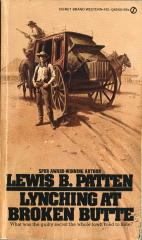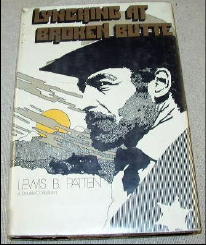Tue 30 Sep 2008
Western Review: LEWIS B. PATTEN – Lynching in Broken Butte.
Posted by Steve under Reviews , Western Fiction[11] Comments
LEWIS B. PATTEN – Lynching in Broken Butte.
Signet, paperback reprint; 1st printing, July 1975. Hardcover edition: Doubleday & Co., 1974.

My review of Prodigal Gunfighter on these pages a short while ago was preceded by a post on Western Noir in which Patten’s name came up in a major way. Both of these posts elicited a substantial number of comments, showing that Patten, for one, is a western author still being read, in spite of his death in 1981, and that the concept of noir and western fiction are not in the least way incompatible.
In fact, Lynching in Broken Butte is one of the books Chap O’Keefe reviews in the latest online issue of Black Horse Extra, in which Western Noir first came up for discussion. When I recently happened across a copy of the paperback edition, I immediately set it aside to read.
Which when I did, took me just over an hour, even though it’s 172 pages long. As is common in Patten’s work, the action in Lynching, omitting the flashback to the incident in question, takes place in just over a day in the life of the town, Broken Butte, so it’s easy to start in on page one and keep on reading. The story never stops, and neither does the reader.
Five months before the story begins is where it really begins, though. Two drifters are jailed and then hanged for raping and killing the 15-year-old daughter of the town’s leading figure, Eric Carberry. When the town learns the next day that the two men were innocent, guilt hangs heavy over all their heads, and it comes to a boil when a US Marshal named August Cragg accidentally chooses Broken Butte as a place to stop over night while on other business.
And thirty hours later, all hell has broken loose. (I may be off on the number of hours. It’s certainly less than two days later, but longer than one, and I am correct on calling it hell.)

The ending comes a little too abruptly for me. With the town sheriff and Clara Easterday and her daughter Nan being held hostage, Cragg finds he has very few options, and makes do with really the only good one. Subtlety does not count in situations like this.
But as a short and incisive morality play, Lynching at Broken Butte fits the bill very nicely, nor does Patten seem to care very much about political correctness. Except for one or two individuals, there are no shades of gray, but those couple of individuals stand out for their conflicted motivations, particularly Sheriff Jasper Horsley, whose innate weakness allowed the lynchings to take place in the first place. Noir? Yes. Indubitably.
One thing does bother the backside of my brain, though. Soon after the lynchings, the true killer of Eloise, Carberry’s rebellious young daughter — a local townsman — is identified, convicted in court, and executed. If I had been he, I’d have threatened to make a fuss about the lynchings. He must not have had a very good lawyer. With a guilty secret like this hanging over the town, it sounds like a deal in the making to me.
[UPDATE] 10-01-08. Here’s how I’d cast the film made from this novel, subject to some second thoughts tomorrow:
Marshal August Cragg – John Payne
Clara Easterday – Peggy Castle
Sheriff Jasper Horsley – Lee J. Cobb
Eric Carberry – Ed Begley
September 30th, 2008 at 2:56 pm
Pleased you found this one indubitably noir, Steve. It’s always reassuring to learn one’s judgement isn’t too far out of kilter with critics more widely read than yourself.
Last week, I read the proofs of Blast to Oblivion, a Black Horse Western publishing in February. Currently, I’m writing the next Joshua Dillard story. I hope both these, too, will be considered in the western noir vein.
Keith
September 30th, 2008 at 3:00 pm
. . . Forgot to say, pleasure to see the US covers of this Patten. Thanks for hunting them out!
K.
October 1st, 2008 at 1:59 pm
Keith
Everyone’s definition of noir is different. Once you move away from movies to fiction, the concept becomes even more vague. I guess we know it when we see it, right?
Best
Steve
October 1st, 2008 at 3:17 pm
Absolutely, Steve! When I wrote the piece for Black Horse Extra, I hunted around a fair bit before deciding James Reasoner and Wikipedia had the takes that were the easiest to understand.
Keith
October 1st, 2008 at 3:39 pm
Keith
I don’t think Wikipedia is much help.
Quoting from their “hardboiled” page, “Noir fiction is the name sometimes given to a mode of crime fiction regarded as a subset of the hardboiled style.”
Whereas I think that “noir” and “hard-boiled” are two overlapping but distinct sub-genres.
Wikipedia does go on to say: “The term ‘noir fiction’ may evoke unrelenting gloom; in fact, while the work of all the major authors in the field might be characterized by a fatalistic attitude, it has been expressed in a variety of tones.”
This is better, but it doesn’t fit my definition.
The problem is, I don’t have a definition myself. To me, it’s an instinctive reaction, and what’s worse, sometimes the reaction may not entirely be what the author intended.
So be it.
— Steve
http://en.wikipedia.org/wiki/Hardboiled
October 1st, 2008 at 4:50 pm
Steve
The Wikipedia definition I liked (and quoted) came from their Film noir page. It linked film and fiction via the crime fiction that emerged in the US during the Depression. (The historical one, not the one we might be facing!)
I don’t believe “noir” is a subset of “hardboiled” either. Much more is required in terms of characters’ motivation and the atmosphere of the settings.
But like you said before, we know it when we see it. I try to put noirish elements in some of my westerns, publisher’s policy allowing.
Keith
October 1st, 2008 at 5:39 pm
Keith
For the benefit of everyone who’s read down these comments so far, here’s the precise paragraph about ‘Film noir’ that you quoted from Wikipedia:
“Film noir is a cinematic term used primarily to describe stylish Hollywood crime dramas, particularly those that emphasize moral ambiguity and sexual motivation. Hollywood’s classic film noir period is generally regarded as stretching from the early 1940s to the late 1950s. Film noir of this era is associated with a low-key black-and-white visual style that has roots in German Expressionist cinematography, while many of the prototypical stories and much of the attitude of classic noir derive from the hardboiled school of crime fiction that emerged in the United States during the Depression.”
This is about as good as any definition is going to get. I particularly like the phrase “low key black-and-white visual style.”
The use of ‘visual style’ emphasizes the fact that film noir and noir fiction exist in two different media, one visual, the other committed to producing visual effects in your mind through the process of reading.
I also note that the ‘film noir’ definition suggests a derivation from the hardboiled school of crime fiction, which I agree with but would once again like to point out that this is not quite the same as saying that noir fiction is a subset of the latter.
Everything I say about noir, fiction or film, is always from the SOTP (seat of the pants) approach, so while I’m happy with what I’ve said just now, maybe I’ll have a different perspective on it tomorrow!
— Steve
October 2nd, 2008 at 4:24 am
Steve,
This is a fascinating discussion on noir!
The subject of visual style in film noir gets a deep dive, in the book “Film Noir Reader”, edited by Alain Silver and James Ursini. This is a collection of articles on film noir that have appeared over the years. It has several highly informed looks at photography in noir. It’s a delightful reading experience.
Mike
October 2nd, 2008 at 3:05 pm
I also recommend “Film Noir Reader” as an excellent collection of articles on film noir. There are also three sequels that are just as fascinating: “Film Noir Reader 2”, 3, and 4. Amazon.com has all four books discounted.
October 2nd, 2008 at 4:00 pm
The Film Noir Reader has a number of articles that explain aspects of visual style in noir. As I said, it takes a “deep dive”: a prolonged, serious, detailed and remarkably informative look at how noir films are actually photographed. Some articles in the first section (seminal articles) look at aspects of noir style across the whole genre. The later case studies on “The Killers” and “Kiss Me Deadly” are also highly informative on photography.
This book is a great way for movie lovers to understand visual style much better.
October 2nd, 2008 at 7:01 pm
Mike & Walker
I have the first three Film Noir Readers, and maybe all four, but I confess that so far I’ve only skimmed through them.
It occurs to me that I really ought sit down and take the time to read them. A lack of basic knowledge about something you’re passionately expounding upon can often be a dangerous thing.
And no, I’m not thinking of any politician in particular.
— Steve